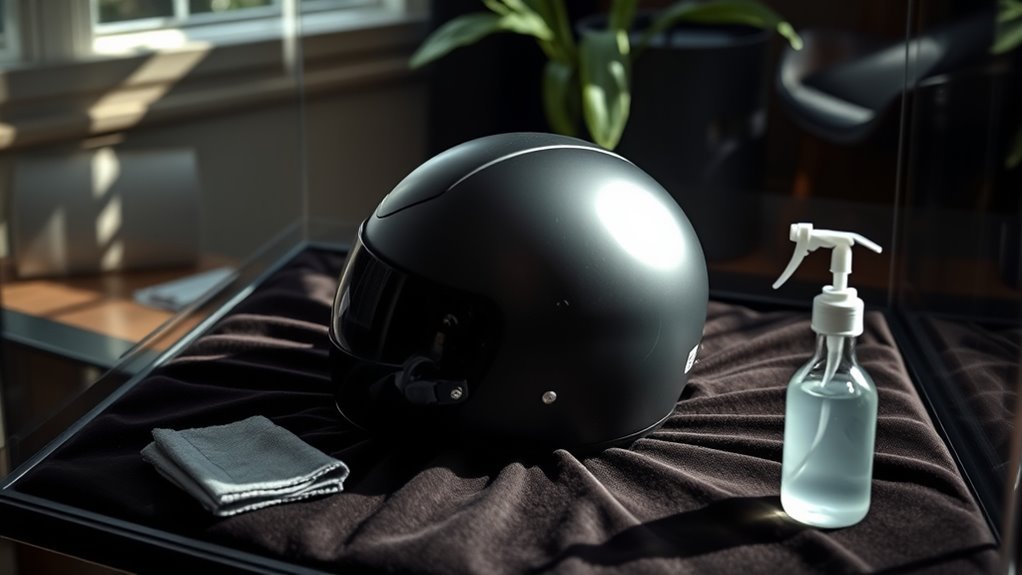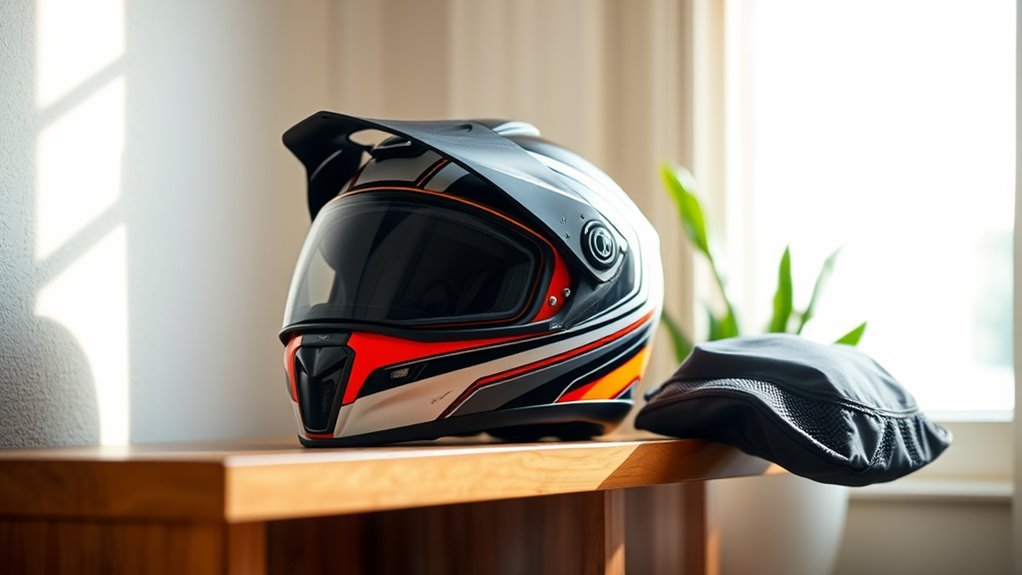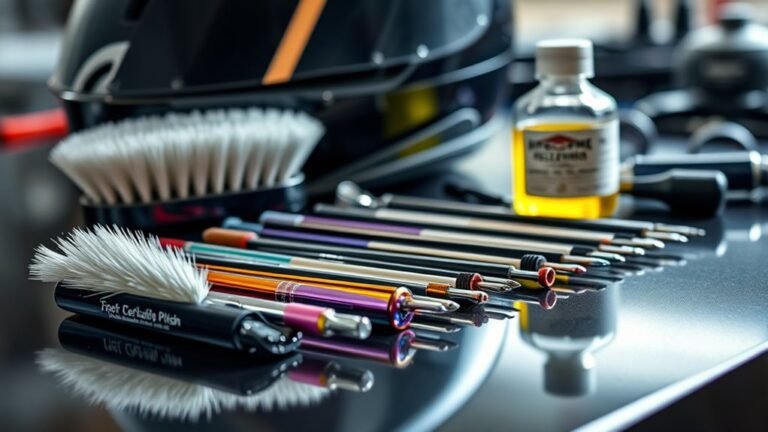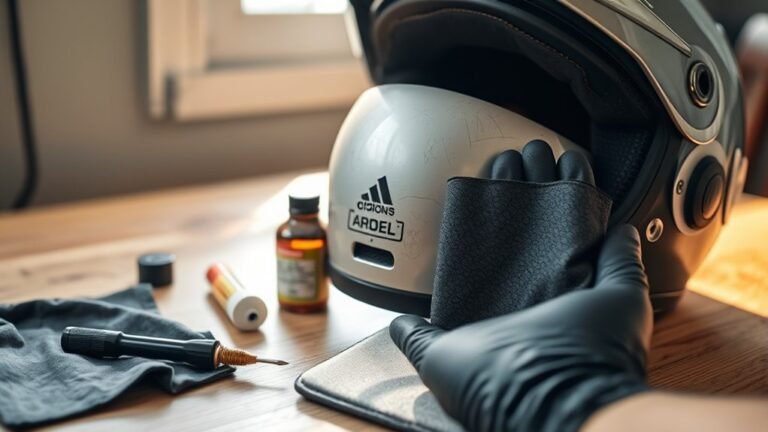Tips for Storing Your Helmet to Prolong Its Life
To prolong your helmet’s life, store it in a cool, dry place away from direct sunlight and extreme temperatures. Use a padded helmet bag or case to protect it from scratches. Always keep it upright on flat surfaces and avoid hanging it by the straps to prevent deformation. Regularly clean your helmet and inspect it for damage. By following these tips, you’ll guarantee safety and longevity for your gear, and there’s more to discover about proper maintenance techniques.
Choose the Right Storage Location

When selecting a storage location for your helmet, it is crucial to take into account both temperature and humidity levels. The ideal environments for helmet storage are cool, dry areas that maintain consistent temperatures. Avoid attics or basements where extreme fluctuations can occur. Instead, consider dedicated storage solutions like a closet or a storage box specifically designed for helmets, ensuring they’re insulated from moisture and heat. This prevents degradation of materials and maintains the helmet’s integrity. Additionally, using silica gel packets can help control humidity within enclosed spaces. By prioritizing these factors, you’re not just protecting your helmet; you’re enhancing its longevity, allowing you to enjoy the freedom of riding with confidence. Make informed choices for superior care.
Keep It Away From Direct Sunlight

To guarantee your helmet remains in peak condition, it is vital to keep it away from direct sunlight. Prolonged sunlight exposure can degrade the materials, compromising both safety and aesthetics. UV protection is essential for maintaining your helmet’s integrity.
| Factor | Impact of Sunlight Exposure |
|---|---|
| Material Degradation | Weakens structural integrity |
| Color Fading | Diminishes visual appeal |
| Safety Compromise | Increases risk during use |
Avoid Extreme Temperatures

Extreme temperatures can greatly affect your helmet’s performance and lifespan. When exposed to temperature extremes—either scorching heat or frigid cold—your helmet’s materials may degrade, compromising safety. High temperatures can soften the foam and weaken the outer shell, while low temperatures may make it brittle. To guarantee ideal climate control, store your helmet in a temperature-regulated environment. This means avoiding garages, attics, or car trunks where temperatures fluctuate wildly. Ideally, keep it in a cool, dry place, away from heaters or air conditioning vents. By taking these precautions, you’re not just prolonging your helmet’s life; you’re also guaranteeing it provides reliable protection when you need it most. Remember, a well-maintained helmet is your best ally on the road.
Use a Helmet Bag or Case
Storing your helmet properly is just as important as protecting it from extreme temperatures. Using a helmet bag or case can greatly extend its lifespan. Look for bags that feature padded interiors to cushion your helmet, preventing scratches and dents. Make sure the bag is made from breathable materials to avoid moisture buildup, which can damage helmet materials over time. Consider options with adjustable straps for easy carrying and a secure fit. A well-constructed case can also protect against impacts during transport. By investing in a quality helmet bag or case, you’re not just storing your gear; you’re safeguarding your freedom to ride safely and enjoyably. Prioritize these features to keep your helmet in prime condition.
Store It in an Upright Position
To maintain your helmet’s integrity, store it in an upright position. This prevents deformation damage, which can compromise its protective capabilities. Additionally, an upright position enhances air circulation, helping to reduce moisture buildup and odors.
Prevent Deformation Damage
While helmets are designed to withstand impact, improper storage can lead to deformation damage that compromises their integrity. To prevent this, always store your helmet in an upright position. This helps maintain its original shape and prevents the foam padding from compressing unevenly. When helmets are laid flat or placed under heavy objects, the pressure can distort the helmet shape, making it less effective in protecting your head during an impact. Additionally, avoid storing your helmet in environments with extreme temperatures, as heat can also lead to foam degradation. By prioritizing proper storage, you guarantee your helmet remains reliable and functional, allowing you the freedom to ride or engage in activities with confidence.
Enhance Air Circulation
Properly enhancing air circulation is essential for maintaining your helmet’s condition, as stagnant air can lead to moisture buildup and unpleasant odors. To achieve ideal air flow, store your helmet in an upright position. This allows for better ventilation, helping to dissipate moisture effectively. Avoid placing your helmet in enclosed spaces where humidity can accumulate, as this compromises moisture control. Instead, consider using a helmet rack or a designated shelf that promotes airflow around the helmet. Additionally, avoid stacking other items on top of it, which can obstruct air circulation. By ensuring your helmet remains upright and well-ventilated, you’ll extend its lifespan and keep it fresh, allowing you to enjoy your rides freely and confidently.
Keep It Clean and Dry
To guarantee your helmet remains in ideal condition, you should regularly wipe it down to remove dirt and moisture. Storing it in a ventilated area helps prevent mold and odors from developing. Proper cleaning and storage practices will extend the life of your helmet considerably.
Regularly Wipe Down
Since helmets are crucial for your safety, keeping them clean and dry is essential for maintaining their integrity and performance. Regularly wipe down your helmet using effective cleaning techniques to prevent dirt, sweat, and grime buildup. Use a damp microfiber cloth to gently clean the exterior, making sure you reach all crevices. For the interior, a light spray of a mild disinfectant can help eliminate odors and bacteria. Avoid harsh chemicals that can degrade materials. Implement these maintenance tips after each ride, especially in wet or muddy conditions. By consistently attending to your helmet’s cleanliness, you not only extend its lifespan but also guarantee that it remains a dependable companion on all your adventures.
Store in Ventilated Area
While you might be tempted to toss your helmet in a corner after a ride, storing it in a ventilated area is crucial for maintaining its condition. Proper ventilation benefits your helmet by promoting air circulation, which aids in humidity control and prevents mold or mildew buildup. Here’s how to guarantee your helmet stays fresh:
- Choose a dry location – Avoid damp areas like basements or garages.
- Use a helmet bag – Opt for one with mesh panels for airflow.
- Hang it up – If possible, suspend it from a hook to encourage ventilation.
- Avoid direct sunlight – Excessive heat can warp the material, affecting its integrity.
Avoid Hanging by the Straps
Hanging your helmet by the straps may seem convenient, but it can lead to deformation and compromise its structural integrity over time. When you hang your helmet this way, the weight can cause strap damage, making it less reliable when you need it most. Instead, consider storing your helmet on a flat surface or in a dedicated helmet bag. This method helps maintain its shape and extends helmet longevity. Remember, your helmet is a key piece of safety gear, and treating it with care guarantees it performs effectively when you ride. So, avoid the temptation to hang it by the straps and choose a more protective storage solution instead. Your safety deserves it.
Regularly Inspect for Damage
Even with proper storage, helmets can still suffer from wear and tear over time. Regular inspections are crucial for effective helmet maintenance and damage assessment. Here are four key areas to check:
- Outer Shell: Look for cracks, dents, or scratches that could compromise structural integrity.
- Padding: Verify padding is intact and free from excessive wear, as it affects comfort and safety.
- Straps: Check for fraying or damage; secure straps are essential for a proper fit.
- Retention System: Test the buckles and adjustments to confirm they function smoothly.
Educate Others on Proper Storage
Properly storing helmets is essential not just for your own safety but also for the well-being of fellow riders. When you educate others on proper storage techniques, you contribute to a culture of safety. Share the importance of keeping helmets in a cool, dry place, away from direct sunlight and extreme temperatures, which can degrade materials. Encourage regular cleaning to remove dirt and sweat, as this can prolong the helmet’s lifespan. Highlight the necessity of using a soft cloth and mild soap, avoiding harsh chemicals. Remind them never to hang helmets by the straps, as this can cause deformation. By sharing these tips, you empower others to protect their gear and enjoy their rides with peace of mind.
Frequently Asked Questions
How Often Should I Replace My Helmet?
You should replace your helmet every 3 to 5 years, regardless of visible wear. While it may seem fine, internal damage can compromise your safety. Replacement indicators include cracks, dents, or foam deterioration. A helmet’s lifespan is essential for your freedom on the road; a faulty helmet can lead to serious consequences. Stay vigilant and prioritize your safety by regularly evaluating your gear for any signs that it’s time for a new one.
Can I Store My Helmet in a Garage?
You shouldn’t store your helmet in a garage. Temperature extremes and high humidity levels can damage its materials, leading to reduced performance and safety. Ideally, helmets should be kept in a cool, dry place away from direct sunlight. If your garage experiences significant temperature fluctuations or moisture, it’s best to find a more stable environment. Protecting your helmet guarantees it remains effective when you need it most, maintaining your freedom on the road.
Is It Safe to Store My Helmet in a Car?
Storing your helmet in a car isn’t recommended due to potential damage from extreme car temperatures and prolonged sunlight exposure. High heat can degrade the helmet’s materials, compromising its safety features. Direct sunlight can also cause fading and weaken the structure. If you must store it in a car, try to keep it shaded and avoid leaving it there for extended periods. Prioritize your helmet’s integrity to guarantee your safety on the road.
What Materials Are Best for Helmet Bags?
For helmet bags, you’ll want nylon fabric for durability and water resistance. Picture your helmet nestled within a soft, padded interior, protected from bumps and scratches as you roam freely. The lightweight nature of nylon makes it easy to carry, while the padding guarantees your helmet stays safe during transport. Look for bags with reinforced stitching and secure closures to keep your gear secure, giving you peace of mind during every adventure.
Can I Use Disinfectants on My Helmet?
You shouldn’t use harsh disinfectant types on your helmet, as they can damage the materials. Instead, opt for mild soap and water or alcohol wipes designed for helmets. When cleaning, avoid soaking the helmet; just gently wipe down surfaces. For the interior, use a soft cloth with a diluted solution of gentle disinfectant. Always check the manufacturer’s guidelines for specific cleaning methods to guarantee you maintain the helmet’s integrity while keeping it sanitary.






